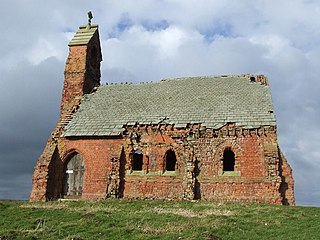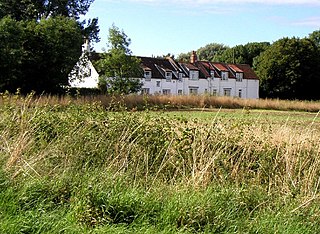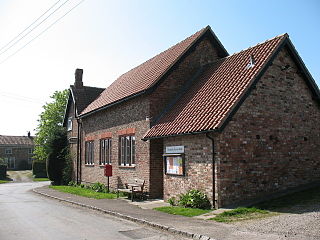
Coxwold is a village and civil parish in the Hambleton District of North Yorkshire, England, in the North York Moors National Park. It is 18 miles north of York and is where the Rev. Laurence Sterne wrote A Sentimental Journey.
Leconfield is a village and civil parish in the East Riding of Yorkshire, England, about 3 miles (5 km) north-west of Beverley town centre on the A164 road. The civil parish consists of Leconfield, the village of Arram and the hamlet of Scorborough. The 2011 UK census gave the parish a population of 2,127, an increase on the 2001 UK census figure of 1,990.

Little Weighton is a village in the East Riding of Yorkshire, England. It is approximately 5 miles (8 km) south-west of Beverley and 4.1 miles (6.6 km) west of Cottingham and forms part of the civil parish of Rowley.
Beningbrough is a village and civil parish in the Hambleton district of North Yorkshire, England. The population as taken at the 2011 Census was less than 100. Details are included in the civil parish of Shipton, North Yorkshire.

Burythorpe is a village and civil parish in North Yorkshire, England, about 4 miles (6 km) south of Malton. According to the 2001 census it had a population of 289, reducing marginally to 286 at the Census 2011. The Whitegrounds barrow is nearby.

Sand Hutton is a village and civil parish which forms the larger part of the Claxton and Sand Hutton grouped parish council, in North Yorkshire, England, about 6 miles (9.7 km) north-east of York.

Felixkirk is a village and civil parish in the Hambleton District of North Yorkshire, England. The village is situated about three miles north-east of Thirsk. The population of the civil parish was estimated at 100 in 2014.

Buttercrambe is a small village in the Buttercrambe with Bossall civil parish, in North Yorkshire, England. Buttercrambe is some 9 miles (14 km) north-east of York, and on average about 56 feet (17 m) above sea level. The settlement is mentioned in the Domesday Book, and the name derives from the Old English of butere and crambe. Crambe is a word meaning bend, and so Buttercrambe's literal translation is rich piece of land in the bend of the river (Derwent).

Cottam is a hamlet and civil parish in the East Riding of Yorkshire, England. The hamlet is west of the B1249 Skipsea to Staxton road, and in the Yorkshire Wolds. It is 16 miles (30 km) north from the county town of Beverley, and approximately 4 miles (6 km) east from the village of Sledmere.

Ruston Parva is a hamlet and former civil parish, now in the parish of Harpham, in the East Riding of Yorkshire, England. It is situated approximately 8 miles (13 km) south-west of Bridlington and lies just north of the A614. In 1931 the parish had a population of 84. On 1 April 1935 the parish was abolished and merged with Harpham.

Nunburnholme is a village and civil parish in the East Riding of Yorkshire, England. It is approximately 3 miles (5 km) east of the market town of Pocklington. The civil parish is formed by the village of Nunburnholme and the hamlet of Kilnwick Percy. According to the 2011 UK census, Nunburnholme parish had a population of 234, a decrease on the 2001 UK census figure of 253.

Danthorpe is a hamlet in the civil parish of Elstronwick and the East Riding of Yorkshire, England, and in an area known as Holderness.

Flaxton is a small village and civil parish in North Yorkshire, England. It is close to the A64 between York and Malton. The village lies entirely within a Conservation Area as defined by Planning 1990.
West Lutton is a village in North Yorkshire, England. It is situated approximately 9 miles (14 km) east from Malton, and within the Yorkshire Wolds. The hamlet of East Lutton is 0.5 miles (0.8 km) to the east. The village lies in the Great Wold Valley and the course of the winterbourne stream the Gypsey Race passes through it.

Swyncombe is a hamlet and large civil parish in the high Chilterns, within the Area of Outstanding Natural Beauty about 4+1⁄2 miles (7 km) east of Wallingford, Oxfordshire, England. Swyncombe hamlet consists almost entirely of its Church of England parish church of Saint Botolph, the former rectory and Swyncombe House. The population of the parish is in the hamlets of Cookley Green and Russell's Water, and the scattered hamlet of Park Corner. The 2011 Census recorded the parish's population as 250. It is partially forested and is the fifth largest of 87 civil parishes in the District.

Thirkleby High and Low with Osgodby is a civil parish in North Yorkshire, England. The parish includes the villages of Great Thirkleby and Little Thirkleby and the scattered hamlet of Osgodby. The similarly named medieval settlement of Thirkleby Manor is around 30 miles north, in the parish of Kirby Grindalythe, Ryedale District. The population of the civil parish taken at the 2011 Census was 266.

The extent of the medieval district of Craven, in the north of England is a matter of debate. The name Craven is either pre-Celtic Britain, Britonnic or Romano-British in origin. However, its usage continued following the ascendancy of the Anglo-Saxons and the Normans – as was demonstrated by its many appearances in the Domesday Book of 1086. Places described as being In Craven in the Domesday Book fell later within the modern county of North Yorkshire, as well as neighbouring areas of West Yorkshire, Lancashire and Cumbria. Usage of Craven in the Domesday Book is, therefore, circumstantial evidence of an extinct, British or Anglo-Saxon kingdom or subnational entity.
Hugh fitzBaldric was a Norman nobleman and royal official in England after the Norman Conquest of England.

St Botolph's Church is the parish church of Bossall, a village in North Yorkshire, in England.
Bossall Hall is a historic building in Bossall, a village in North Yorkshire in England.
















